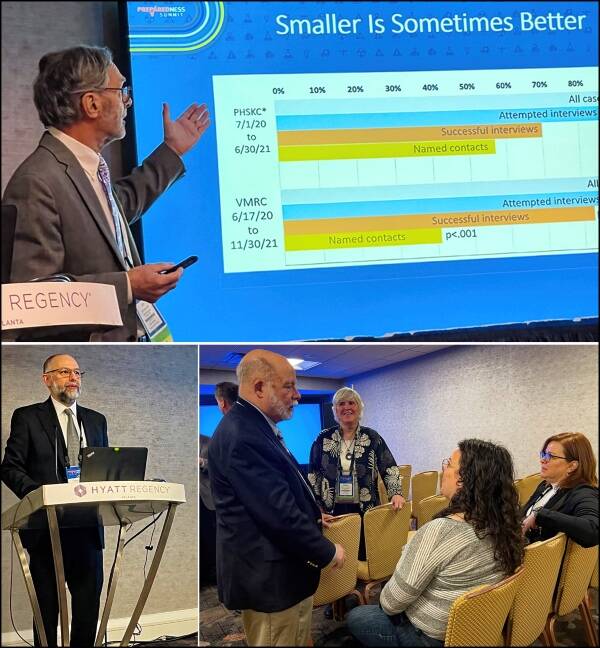A team of four VashonBePrepared volunteers flew to Atlanta in late April to share lessons learned from the island pandemic response with a national audience of public health experts.
They spoke at the annual preparedness conference of the National Association of City and County Health Officers (NACCHO).
At the conference, Medical Reserve Corps (MRC) co-coordinator Dr. Jim Bristow described study results showing that Vashon had about a third of the COVID rate experienced in mainland King County.
Dr. Clayton Olney, also a co-coordinator of the MRC, described Vashon’s innovative testing program. Rick Wallace set the context of the response from the Emergency Operations Center (EOC) point of view. Wallace is the manager of the ECO.
Marijke van Heeswijk, who serves as the EOC’s mass care section chief, provided lessons learned from Vashon’s COVID vaccination program.
The audience came from across the nation and included Michelle McGaughey and Kylie Sage, from Salt Lake County Health Department, in Utah.
Hot and Cold: Advice for Swimming and Wildfire Seasons
It can be a major shock to your system — actually dangerous — to plunge into Puget Sound’s chilly swimming waters, especially on one of our warm spring days. It may seem like it would be refreshing, but jumping into water 70 degrees or lower may cause what’s called cold-water shock. It’s a killer. So, before you head for the lake, ocean, or pool, check out the Washington State Parks page on cold-water safety here.
Though our Puget Sound marine climate reduces the risk of cataclysmic wildfire on Vashon, even a small runaway wildfire could take out several houses before needed help could arrive here by ferry. Check out the excellent and practical information on Vashon Island Fire & Rescue’s wildland fire safety page here.
Current COVID Risk Level: Basic
VashonBePrepared recommends the following safety measures for Vashon’s current Basic Risk level.
Wear an N95 mask indoors in public if you are exposed to COVID, at risk for health or other reasons, or live with or spend time with someone at high risk.
Keep vaccinations up to date, including boosters. Maintain good ventilation at home and at work.
Avoid those with suspected or confirmed COVID. If exposed to COVID, wear a mask in public and avoid contact with those at high risk for 10 days.
Always home-test if you have symptoms. If you test positive, isolate for at least 5 days and until you test negative. If immunocompromised, discuss additional prevention actions with your healthcare provider.
Do You Feel Like the Weird Masked One? Advice from Jinna
You find yourself thinking: Am I going to be the only one wearing a mask? Am I going to feel like the weird one? It has become a familiar feeling, hasn’t it?
As mask mandates have lifted across the country, more people have experienced that odd feeling of being the only one in the room, grocery store, or office wearing a mask.
In many cases, the peer pressure to conform to specific behaviors based on what other members of a group are doing is enough to motivate someone to ditch their mask, despite their best judgment. Even when they know the risks and would normally choose to mask if more people were doing so.
We are social animals. We like to behave in similar ways in a group. I was on an international flight recently and was one of only a few people aboard wearing a mask. I felt like an outlier, but I also did not want to get COVID on a crowded flight. And I did not contract COVID.
Going against the norm can make you feel distressed and anxious, even if no one uses overt peer pressure or intimidation to change your decision to mask.
Conforming to a clear set of rules or standards is easier for people. For example, in the Puget Sound region in-patient-care settings in hospitals, masking is still mandated, so everyone knows what to do.
What helps us resist indirect or unspoken peer pressure to conform? Identify others in a group setting who are also masked, so you don’t feel like you are the only one. Also, look for leaders in a group setting (think teachers, principals, managers) who are masked up, and feel empowered to follow their example.
What about the kids? Children feel indirect peer pressure to conform as much as adults do in group settings. UC Davis psychologist Brandi Hawk said that family values, open discussions, and modeling desired behavior are three factors that can make a difference in whether a child succumbs to, or stands up to, indirect peer pressure.
“If children are told to do something and then see their parents doing the opposite, it makes the message less salient and easier to ignore,” Hawk said.
Parents who want to reinforce the importance of masking with their children should model wearing masks whenever they are in public.
“Parents should also have direct, open conversations that explicitly state they want their children to continue to mask at school and explain why masking aligns with their family values,” Hawk said. “When children understand why they should or should not do something, it becomes a little easier to resist peer pressure.”


